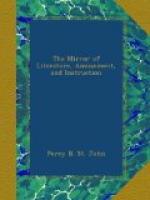At the time of Bewick’s first entering into active life, the art of wood-engraving had fallen into the lowest repute. Few of its specimens were superior to the pictures on street ballads of the present day. To explain Bewick’s improvements would occupy too much of our space, but, we may observe, generally that the engravings of the above period were mere patches of black and white, till Bewick introduced those beautiful reliefs, or varieties of light and shade which principally form the pictorial effect of an engraving. By this means he raised wood-engraving from a state of contempt to the rank of one of the fine arts.
The first specimen of his talents by which Bewick made himself publicly known was a cut of an old hound, for which, in 1755, he received a premium from the Society of Arts. The block had been cut for an edition of Gay’s fables; the complete work appeared in 1779; and immediately attracted general attention by the striking superiority of its embellishments, which were all from wood-cuts executed by Bewick and his younger brother John, who, when Beilby and he entered into partnership, had become their apprentice. From this time the reputation of the artist went on increasing steadily, and he produced a succession of works which very soon gave altogether a new character to his art itself.
Bewick’s principal work, or that which established his fame, was his History of Quadrupeds, which appeared in 1790. He had been employed many years in preparing this publication, all the cuts in which were not only engraved by himself or his brother, but were all copied from his own drawings. He had cultivated his early talent for the delineation of animals with unwearied industry: he had not the advantages of academical studies, which education in the metropolis might have afforded him, but he drew from life, taking sketches of all the striking specimens that came under his notice, and visiting whatever menageries of exotic animals were brought to Newcastle.[2] Thus he studied assiduously from nature, and to this course may be attributed the excellence of the cuts in the History of Quadrupeds. Many of the vignettes also, with which this publication was adorned, had uncommon merit as original sketches; for Bewick did not confine his pencil to the mere delineation of animals. His vignettes have been said to partake of his determinate propensity to morality, tenderness, and humour; each telling articulately its own tale.[3] and bearing in every line a lesson.




